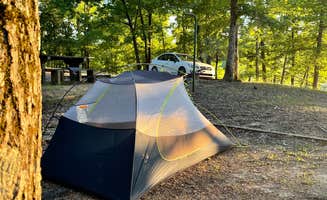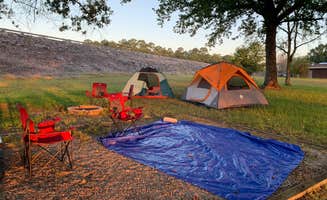Tent camping near New Albany, Mississippi centers around Holly Springs National Forest's 156,000 acres of mixed pine and hardwood forest. The region experiences hot, humid summers with temperatures regularly exceeding 90°F and mild winters with occasional freezing nights. Most campgrounds in this area sit at elevations between 300-500 feet above sea level, with natural terrain consisting of sandy soil that drains quickly after rainfall.
What to do
Fishing opportunities: Puskus Lake in Holly Springs National Forest offers bass and bream fishing from shoreline or dock. "Fun little quick trip to paddle around in kayak, fish & enjoy great meal over grill," notes camper David H. The lake features concrete boat launches and wide docks with bench seating.
Trail exploration: Cox Lake provides access to unmaintained forest trails. "Great little fishing lake," reports camper B C. Though trails aren't extensively developed, the surrounding Holly Springs National Forest offers self-guided hiking opportunities through pine and hardwood forests.
Water activities: Beach Point at Sardis Lake provides lake access for swimming and paddling. "The view and proximity to the water is truly what makes this spot," writes McKinley L. Most waterfront sites require walking gear from parking areas to campsites, with some restrictions on motorized watercraft depending on season.
What campers like
Peaceful atmosphere: Graham Lake offers quiet camping without crowds. "It's rather nice there. This is a very small campground with about 5 spots," notes Steve G. Sites typically offer more separation than developed campgrounds, with minimal traffic noise except at locations near highways.
Budget-friendly options: Puskus Lake Recreation Area provides affordable tent camping with basic amenities. "It is also relatively cheap to camp there which is always great!" writes Kim N. Sites typically cost $7 per night with discounts for interagency pass holders, making this area suitable for budget-conscious campers.
Wildlife viewing: Numerous tent sites provide opportunities to observe local wildlife. "Inside Holly Springs National Forest," notes camper B C. about Cox Lake, highlighting the natural setting. Early mornings offer the best wildlife viewing, with deer, various bird species, and small mammals frequently spotted near water sources.
What you should know
Seasonal considerations: Campgrounds experience varying usage patterns throughout the year. "I camped here just one night in May 2021 on a Saturday, I got there at about 3pm and was the first there but by nightfall every site was full," reports Natalee F. about Puskus Lake. Summer weekends typically reach capacity by Friday afternoon.
Facility limitations: Many sites have minimal amenities and maintenance issues. "Bathrooms are closed, and have been for some time. For $8 you could do worse," notes Steve G. about Beach Point. Always bring toilet paper, as even functioning facilities often lack supplies.
Weather preparedness: The region experiences frequent summer thunderstorms and high humidity. "The flies!! They were so so bad! And bighty!!" reports Elizabeth S. about her experience at Beach Point. Insect repellent is essential from April through October, along with rain protection for tents during summer months.
Tips for camping with families
Site selection: Choose areas with space for activities. "Large rigs are a no go I would think, as access can be tight. If you're in a small to medium travel trailer or a tent, this could work out," explains Steve G. about Graham Lake. Sites near water typically offer better air circulation during hot summer months.
Safety considerations: Most campgrounds lack lighting after dark. "We reserved campsites 13 and 14, at the far end, behind the restrooms. You have to park in the parking lot and carry your stuff to the site," notes Elizabeth S. about Beach Point. Bring lanterns and flashlights for navigating after sunset.
Activity planning: Elmers Hill provides tent-only camping with water access. "Nice little spot with about 8 tent sites. No hookups of any kind for campers," writes Steve G. Pack board games and activities for children during midday heat when outdoor exploration becomes uncomfortable.
Tips from RVers
Access limitations: Many campgrounds restrict vehicle size. "This is a tent only kind of place," reports Steve G. about Hays Crossing. Most dirt access roads become difficult to navigate during or after rainfall, particularly for larger vehicles.
Boondocking options: Graham Lake accommodates self-contained camping. "No hookups. Nothing. But, it is a free campground so what can you say," notes Steve G. Bring all necessary supplies, including drinking water, as many locations lack potable water sources or have unreliable pumps.
Site preparation: Tent sites typically have minimal grading. "We went in the off season so it was free!" reports McKinley L. about Beach Point. Bring extra ground cloth or padding as most sites feature natural, uneven terrain with occasional tree roots and rocks.



